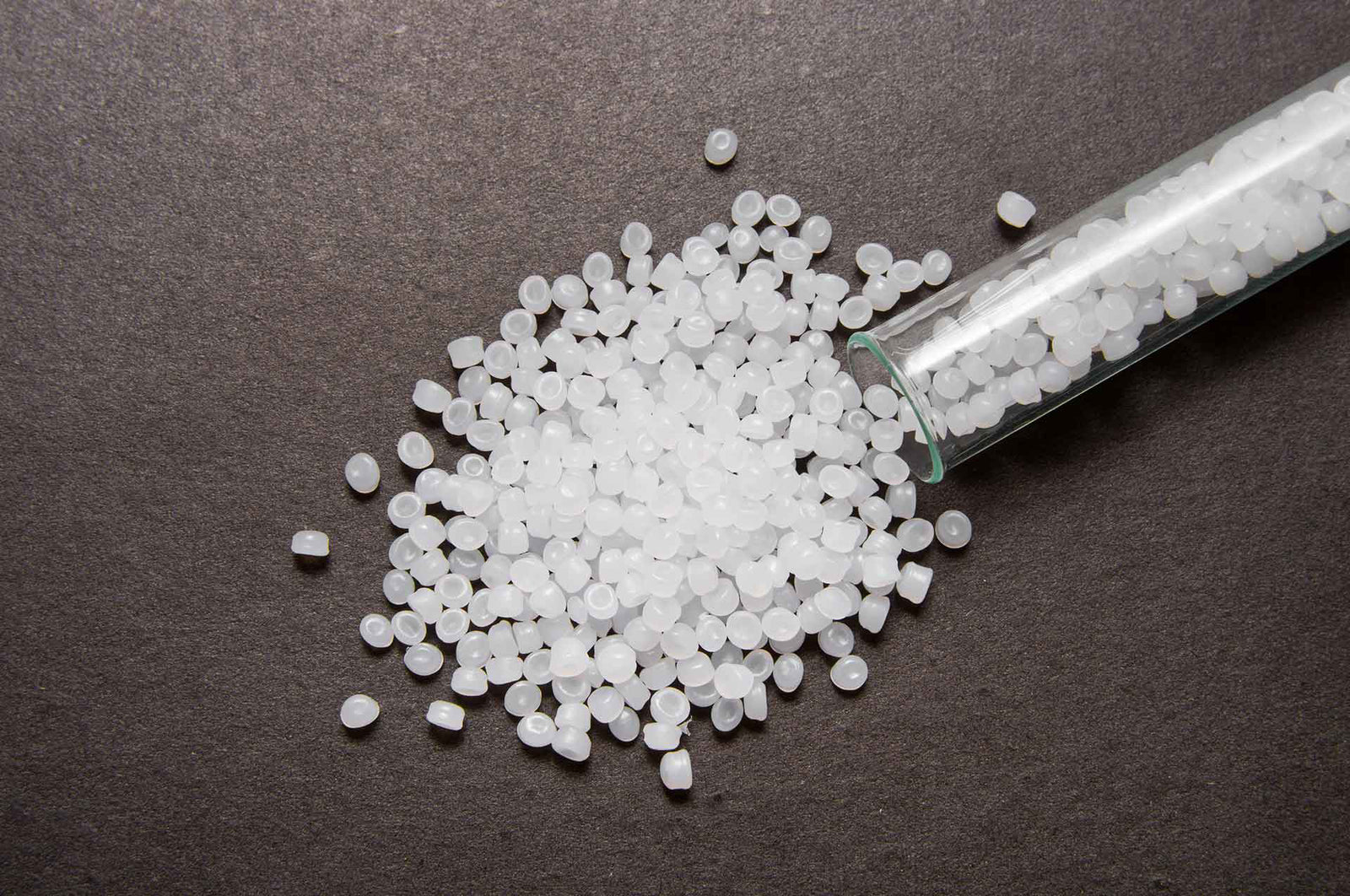Nhựa PE là loại nhựa nhiệt dẻo được sử dụng rộng rãi nhất trên thế giới với sản lượng hàng năm lên đến hàng triệu tấn. Loại nhựa này nổi tiếng với tính chất linh hoạt, bền bỉ, giá thành rẻ và khả năng ứng dụng đa dạng trong nhiều lĩnh vực khác nhau. Hãy cùng EQUO khám phá về nhựa PE, từ tính chất cơ bản đến các ứng dụng phổ biến mà nó mang lại trong bài viết sau nhé!
1. Giới thiệu chung về nhựa PE
Nhựa PE là một trong những loại nhựa phổ biến và quan trọng nhất, đóng vai trò không thể phủ nhận trong đời sống hàng ngày của chúng ta.
1.1. Nhựa PE là gì?
Nhựa PE (hay Polyethylene), là một loại nhựa polymer phổ biến được sử dụng rộng rãi, được tổng hợp từ monome ethylene (C2H4). Nhựa PE có các đặc tính như độ bền cao, khả năng chống ăn mòn, độ cách điện tốt và khả năng chịu nhiệt, làm cho nó trở thành nguyên liệu quan trọng trong sản xuất bao bì, ống nước, đồ chơi, túi nilon, và nhiều sản phẩm tiêu dùng khác.

- Thời Gian Nhựa Phân Hủy Trong Môi Trường Tự Nhiên Là Bao Lâu?
- Ống Hút PLA: Những Điều Bạn Nên Biết Về Nhựa Phân Hủy Sinh Học
- Hạt Vi Nhựa Là Gì? Tồn Tại Ở Đâu? Tác Hại Đến Sức Khỏe Thế Nào?
- 10 Ý Tưởng Sáng Tạo Bảo Vệ Môi Trường Độc Đáo Từ Tái Chế & Sản Xuất
- 10+ Vật Liệu Thay Thế Nhựa: Biện Pháp Hoàn Hảo Cho Môi Trường Và Con Người
1.2. Tính chất quan trọng của nhựa PE
Nhựa polyethylene có nhiều tính chất quan trọng như sau:
- Khả năng cách điện tốt.
- Khả năng chống ăn mòn, chịu được các tác động từ hóa chất và axit.
- Khả năng chống nước và thấm nước.
- Có độ dẻo cao, khả năng chịu va đập tốt và dễ uốn cong.
- Có thể tái chế và làm mới thành sản phẩm mới một cách dễ dàng, giúp giảm lượng rác thải nhựa trong môi trường và thúc đẩy phát triển bền vững.
1.3. Nhựa PE có độc không?
PE là một loại nhựa an toàn và không độc hại khi tiếp xúc với thực phẩm và nước. Tuy nhiên, như mọi vật liệu khác, việc sử dụng PE cần tuân thủ các quy định an toàn và hướng dẫn của nhà sản xuất để đảm bảo an toàn cho sức khỏe con người và môi trường.
Mặc dù PE không chứa các hợp chất độc hại như PVC (polyvinyl chloride) hoặc các chất phụ gia độc hại khác, nhưng trong trường hợp đốt cháy, PE có thể phát sinh ra các khí độc hại và hại cho sức khỏe. Do đó, việc xử lý và tái chế nhựa PE cần được thực hiện đúng cách để tránh gây hại cho môi trường và sức khỏe con người.

Nhựa PE không chỉ mang lại những ứng dụng đa dạng và tiện ích trong đời sống hàng ngày mà còn đóng vai trò quan trọng trong việc giảm thiểu tác động của con người đối với môi trường. Tuy nhiên, việc sử dụng và xử lý PE cần được thực hiện đúng cách, đồng thời khuyến khích việc tái chế và sử dụng bền vững để giảm thiểu tác động tiêu cực đến môi trường.
2. Nhựa PE có bao nhiêu loại?
Nhựa polyethylene (PE) có nhiều loại khác nhau, được phân loại dựa trên mật độ, cấu trúc phân tử và tính chất vật lý. Dưới đây là một số loại phổ biến của nhựa PE:
2.1. Nhựa PE mật độ thấp (LDPE)
Nhựa LDPE (Low-Density Polyethylene) được sử dụng rộng rãi trong thiết bị phòng thí nghiệm, ống túi nhựa, bao bì và chai lọ. Trong đó, túi nhựa hay túi gói hàng được làm phổ biến nhất là từ nhựa LDPE.
2.2. Nhựa PE mật độ trung bình (MDPE)
Nhựa PE mật độ trung bình (MDPE) có mật độ và độ cứng vừa phải, cao hơn LDPE nhưng thấp hơn HDPE. MDPE thường được sử dụng cho các ứng dụng đòi hỏi độ bền và chịu va đập, như ống dẫn nước và ống dẫn khí đốt.
2.3. Nhựa PE mật độ cao (HDPE)
Nhựa PE mật độ cao (HDPE) là loại nhựa có mật độ cao, cấu trúc phân tử đồng đều. HDPE thường được sử dụng trong nhiều ứng dụng khác nhau như sản xuất ống dẫn nước, bao bì, đồ chơi, đồ gia dụng và nhiều sản phẩm khác.
2.4. Nhựa PE mật độ thấp tuyến tính (LLDPE)
Nhựa PE mật độ thấp tuyến tính (LLDPE) là một loại nhựa polyethylene với cấu trúc phân tử tuyến tính, khác biệt so với cấu trúc gần như ngẫu nhiên của nhựa LDPE. LLDPE thường có tính linh hoạt và độ bền cao hơn so với LDPE, cũng như khả năng chịu va đập tốt hơn. Loại nhựa này thường được sử dụng trong sản xuất túi ni-lông, bao bì linh hoạt và các ứng dụng đòi hỏi tính linh hoạt cao.
2.5. Nhựa PE liên kết chéo (PEX hay XLPE)
Nhựa PE liên kết chéo (PEX hay XLPE) là một dạng của polyethylene có cấu trúc phân tử được liên kết chéo bằng các liên kết hóa học. Điều này tạo ra một loại nhựa có tính chất cơ học vượt trội, độ co giãn tốt và khả năng chịu nhiệt, chịu hóa chất cao. PEX thường được sử dụng rộng rãi trong hệ thống ống dẫn nước nóng và ống dẫn nhiệt do khả năng chịu nhiệt và khả năng cách nhiệt của nó.
2.6. Nhựa PE khối lượng phân tử cực cao (UHMWPE)
Nhựa PE có khối lượng phân tử cực cao, được biết đến với tên gọi UHMWPE (Ultra-High Molecular Weight Polyethylene). UHMWPE có khối lượng phân tử rất lớn, tạo ra tính chất đặc biệt như độ bền cao, khả năng chống mài mòn và ma sát thấp. Vì tính chất này, UHMWPE thường được sử dụng trong các ứng dụng đòi hỏi sự bền vững cao như trong công nghiệp hàng không, y tế (như trong việc sản xuất các bộ phận nội khớp nhân tạo), thể thao (ví dụ như trong việc sản xuất tấm trượt dầu cho ván trượt tuyết) và trong sản xuất các bộ phận máy móc chịu mài mòn. UHMWPE cũng được sử dụng trong các ứng dụng chống đạn và chống cắt do tính chất chống đâm cao.
Nhựa PE có nhiều loại khác nhau, từ LDPE cho đến UHMWPE, mỗi loại đều có tính chất và ứng dụng riêng biệt. Sự đa dạng này của nhựa PE đã làm cho nó trở thành một nguyên liệu quan trọng trong nhiều lĩnh vực.
3. Ưu nhược điểm của nhựa PE
Nhựa polyethylene (PE) đã trở thành một trong những loại nhựa được sử dụng nhiều trên thế giới. Tuy nhiên, như mọi vật liệu, nhựa PE cũng có những ưu và nhược điểm riêng.
3.1. Ưu điểm của nhựa PE
- PE là vật liệu không thấm nước.
- PE chịu được tác động từ hóa chất và axit.
- Có độ dẻo cao, khả năng chịu va đập tốt và dễ uốn cong.
- Có thể tái chế và làm mới thành sản phẩm mới một cách dễ dàng.

Nguồn: Internet
3.2. Nhược điểm của nhựa PE
- PE có điểm nóng chảy thấp, dễ bị biến dạng khi tiếp xúc với nhiệt độ cao.
- Khả năng chịu nhiệt hạn chế so với một số loại nhựa khác.
- Khả năng chống UV kém.
- Dễ bị xước và mài mòn.
- Bề mặt của PE có thể trơn trượt, làm cho nó không phù hợp cho một số ứng dụng đòi hỏi tính chất không trơn trượt cao.
- Không thể phân huỷ, gây trầm trọng thêm tình trạng ô nhiễm nhựa và ảnh hưởng đến môi trường.
Nhựa polyethylene (PE) mang lại nhiều ưu điểm như khả năng chống axit, kháng hóa chất và độ bền cao, làm cho nó trở thành nguyên liệu không thể thiếu trong nhiều ngành công nghiệp và tiêu dùng. Tuy nhiên, cũng cần lưu ý đến nhược điểm như độ dẻo không đồng đều và dễ bị biến dạng nếu không được xử lý đúng cách. Chính vì những nhược điểm này mà nhiều người ưa chuộng sản phẩm tự nhiên thay vì nhựa vì tin tưởng vào lợi ích cho sức khỏe và môi trường.
4. Ứng dụng phổ biến của nhựa PE trong đời sống
Nhựa polyethylene (PE) đã trở thành một phần không thể thiếu trong đời sống hàng ngày của chúng ta với nhiều ứng dụng phổ biến, từ việc đóng gói thực phẩm đến sản xuất đồ dùng gia đình và các ứng dụng trong ngành công nghiệp.
4.1. Sản xuất màng bọc, bao bì thực phẩm nhựa
Các sản phẩm nhựa PE như túi ni-lông, túi zip, bọc thức ăn và túi đựng đông lạnh thường được sử dụng để đóng gói và bảo quản thực phẩm trong các cửa hàng, siêu thị và gia đình. Nhựa PE cũng được sử dụng để sản xuất lớp bảo vệ trong bao bì hộp carton, giúp bảo vệ sản phẩm chống ẩm, bụi và các tác nhân bên ngoài khác.

Nguồn: Internet
Liên quan đến thực phẩm, người tiêu dùng sẽ muốn hướng đến những sản phẩm có tính an toàn cao hơn như được làm từ thiên nhiên và đặc biệt là có thể phân huỷ để bảo vệ môi trường. Vì vậy nhựa PP không thực sự là lựa chọn mà người tiêu dùng muốn hướng đến.
EQUO: Dòng sản phẩm nguyên liệu thiên nhiên, giải pháp hoàn hảo thay thế nhựa
EQUO cung cấp đa dạng các sản phẩm thân thiện với môi trường, đồng hành cùng bạn và giúp bạn dễ dàng thay thế các sản phẩm nhựa dùng một lần trong cuộc sống hàng ngày.
Các sản phẩm của EQUO được làm từ nguồn nguyên liệu tự nhiên 100%, không chứa nhựa và có thể tự phân huỷ trong vòng 3-6 tháng:
- Bộ ống hút thiên nhiên tự phân huỷ: Được làm từ cà phê, bã mía, dừa, cỏ bàng và gạo, an toàn cho sức khỏe, tự phân hủy hoàn toàn trong môi trường tự nhiên.
- Hộp đựng thực phẩm: Được làm từ bã mía, là một nguồn nguyên liệu tự nhiên bền vững có thể tái tạo và phân huỷ một cách nhanh chóng. Đặc điểm nổi bật của sợi bã mía nằm ở tính chất bền chắc, linh hoạt trong khả năng đóng gói, và chất lượng thoáng khí, không thấm nước.
- Bộ dao, muỗng, nĩa: Đây là một lựa chọn tuyệt vời cho những ai đang tìm kiếm một bộ đồ ăn thân thiện với môi trường và bền đẹp.
- Bộ ly giấy với công nghệ tráng nước: Sử dụng công nghệ tráng nước, không tráng nhựa (PP, PE hoặc PLA) giúp quá trình sản xuất ít thải ra khí carbon và khi phân hủy không để lại các tác động xấu đến môi trường như ly giấy thông thường. Phân hủy hoàn toàn trong môi trường tự nhiên trong vòng 18 tuần, đa dạng kích thước, phù hợp cho nhiều mục đích sử dụng.
Hãy cùng EQUO chung tay sử dụng các sản phẩm thân thiện với môi trường, để biết thêm thông tin về các dòng sản phẩm EQUO, mời bạn truy cập link sau:
>> https://shopequo.com/vi/collections

4.2. Sản xuất đồ dùng nhà bếp
Đồ dùng nhà bếp như thớt, khay đựng thực phẩm, hộp đựng đồ ăn, ly, chén và đũa thường được sản xuất từ nhựa PE. Sự dẻo dai và dễ vệ sinh của nhựa PE làm cho chúng trở thành lựa chọn phổ biến cho việc sử dụng hàng ngày trong nhà bếp.

Nguồn: Internet
4.3. Sản xuất túi rác
Nhựa PE cũng được sử dụng để sản xuất túi rác với các loại khác nhau như túi đen thông thường, túi rác màu, túi rác tái chế và túi rác sinh học. Túi rác PE giúp thuận tiện trong việc thu gom và vận chuyển chất thải, bảo vệ môi trường khỏi ô nhiễm và giúp quản lý chất thải một cách hiệu quả.

Nguồn: Internet
4.4. Sản xuất màng chống thấm trong xây dựng
Loại màng PE này được sử dụng để ngăn nước từ việc thấm vào các cấu trúc xây dựng, như móng, tường và sàn nhà giúp bảo vệ và gia tăng tuổi thọ của các công trình xây dựng. Nước có thể gây ra nhiều vấn đề như làm mềm móng, làm mục nát vật liệu xây dựng, gây ẩm mốc. Màng PE bảo vệ cơ sở hạ tầng xây dựng và đảm bảo tính bền vững và an toàn cho các công trình xây dựng trong thời gian dài.

Nguồn: Internet
4.5. Sản xuất màng phủ nông nghiệp
Nhựa PE cũng được sử dụng để sản xuất màng phủ trong nông nghiệp. Những màng này được sử dụng để bảo vệ cây trồng khỏi cỏ dại, côn trùng và thời tiết khắc nghiệt. Nhựa PE giúp tăng cường sự sinh trưởng và bảo tồn sự chất lượng của các vườn trồng và ruộng nông nghiệp.

Nguồn: Internet
Nhựa PE (polyethylene) hiện diện khắp mọi nơi trong cuộc sống của chúng ta, từ việc bảo quản thực phẩm cho đến xây dựng cơ sở hạ tầng. Nhờ sự đa dạng và linh hoạt, PE đóng vai trò thiết yếu trong việc tạo ra các giải pháp đóng gói, bảo vệ và tiện ích cho nhiều mục đích khác nhau.
Nhựa PE là loại nhựa dẻo dai, giá rẻ, dễ gia công và có nhiều ứng dụng trong đời sống. Nhờ những ưu điểm nổi trội này, PE đã trở thành loại nhựa phổ biến nhất trên thế giới, được sử dụng trong sản xuất bao bì, đồ dùng gia đình, công nghiệp, y tế,... Tuy nhiên, việc sử dụng quá nhiều nhựa PE cũng dẫn đến những vấn đề về môi trường. Do đó, chúng ta cần sử dụng nhựa PE một cách hợp lý và có ý thức, đồng thời đẩy mạnh tái chế để giảm thiểu rác thải nhựa bằng cách sử dụng các sản phẩm thay thế có nguồn gốc thiên nhiên như sản phẩm của EQUO.






